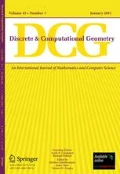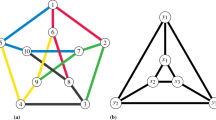Abstract
We study shortest paths and their distances on a subset of a Euclidean space, and their approximation by their equivalents in a neighborhood graph defined on a sample from that subset. In particular, we recover and extend the results of Bernstein et al. (Graph approximations to geodesics on embedded manifolds, Tech. Rep., Department of Psychology, Stanford University, 2000). We do the same with curvature-constrained shortest paths and their distances, establishing what we believe are the first approximation bounds for them.


Similar content being viewed by others
Notes
A ‘pseudo-metric’ is like a metric except that it needs not be definite.
For a definition of geodesics, see [23, Chap. 4].
For example, the points where a shortest path switches from the (relative) interior and the boundary can have a closure of positive measure; this is true even in the case of a domain [1].
Here, \(r \nearrow s\) means that r approaches s from the left, and similarly, \(t \searrow s\) means that t approaches s from the right, on the real line.
The computation of curvature-constrained shortest path distances can be done by adapting Dijkstra’s algorithm. It is implemented in [4, Alg. 1].
References
Albrecht, F., Berg, I.D.: Geodesics in Euclidean space with analytic obstacle. Proc. Am. Math. Soc. 113(1), 201–207 (1991)
Alexander, R., Alexander, S.: Geodesics in Riemannian manifolds-with-boundary. Indiana Univ. Math. J. 30(4), 481–488 (1981)
Alexander, S.B., Berg, I.D., Bishop, R.L.: The Riemannian obstacle problem. Illinois J. Math. 31(1), 167–184 (1987)
Babaeian, A., Babaee, M., Bayestehtashk, A., Bandarabadi, M.: Nonlinear subspace clustering using curvature constrained distances. Pattern Recognit. Lett. 68(2), 118–125 (2015)
Babaeian, A., Bayestehtashk, A., Bandarabadi, M.: Multiple manifold clustering using curvature constrained path. PloS ONE 10(9), Art. No. e0137986 (2015)
Bauer, U., Polthier, K., Wardetzky, M.: Uniform convergence of discrete curvatures from nets of curvature lines. Discrete Comput. Geom. 43(4), 798–823 (2010)
Bernstein, M., De Silva, V., Langford, J.C., Tenenbaum, J.B.: Graph approximations to geodesics on embedded manifolds. Tech. Rep., Department of Psychology, Stanford University (2000)
Boissonnat, J.-D., Cérézo, A., Leblond, J.: Shortest paths of bounded curvature in the plane. In: Proceedings the IEEE International Conference on Robotics and Automation, pp. 2315–2320 (1992)
Burago, D., Burago, Yu., Ivanov, S.: A Course in Metric Geometry. Graduate Studies in Mathematics. American Mathematical Society, Providence (2001)
De Silva, V., Tenenbaum, J.B.: Global versus local methods in nonlinear dimensionality reduction. Adv. Neural Inf. Process. Syst. 15, 705–712 (2002)
Delling, D., Sanders, P., Schultes, D., Wagner, D.: Engineering route planning algorithms. In: Lerner, J., Wagner, D., Zweig, K.A. (eds.) Algorithmics of Large and Complex Networks. Lecture Notes in Computer Science, vol. 5515, pp. 117–139. Springer, Berlin (2009)
Dubins, L.E.: On curves of minimal length with a constraint on average curvature, and with prescribed initial and terminal positions and tangents. Am. J. Math. 79(3), 497–516 (1957)
Federer, H.: Curvature measures. Trans. Am. Math. Soc. 93(3), 418–491 (1959)
Hoffmann, T.: Discrete Differential Geometry of Curves and Surfaces. COE Lecture Note, vol. 18. Kyushu University, Fukuoka (2009)
Janson, L., Schmerling, E., Clark, A., Pavone, M.: Fast marching tree: a fast marching sampling-based method for optimal motion planning in many dimensions. Int. J. Robot. Res. 34(7), 883–921 (2015)
Karaman, S., Frazzoli, E.: Optimal kinodynamic motion planning using incremental sampling-based methods. In: Proceedings of the 49th IEEE Conference on Decision and Control (CDC’10), pp. 7681–7687 (2010)
Karaman, S., Frazzoli, E.: Sampling-based algorithms for optimal motion planning. Int. J. Robot. Res. 30(7), 846–894 (2011)
Kavraki, L.E., Kolountzakis, M.N., Latombe, J.C.: Analysis of probabilistic roadmaps for path planning. IEEE Trans. Robot. Autom. 14(1), 166–171 (1998)
Kruskal, J.B., Seery, J.B.: Designing network diagrams. In: General Conference on Social Graphics, pp. 22–50 (1980)
Latombe, J.-C.: Robot Motion Planning. The Springer International Series in Engineering and Computer Science, vol. 124. Springer, New York (2012)
LaValle, S.M.: Planning Algorithms. Cambridge University Press, Cambridge (2006)
LaValle, S.M., Kuffner, J.J.: Randomized kinodynamic planning. Int. J. Robot. Res. 20(5), 378–400 (2001)
Lee, J.M.: Riemannian Manifolds: An Introduction to Curvature. Graduate Texts in Mathematics, vol. 176. Springer, New York (2006)
Li, Y., Littlefield, Z., Bekris, K.E.: Sparse methods for efficient asymptotically optimal kinodynamic planning. In: Akin, H.L., et al. (eds.) Algorithmic Foundations of Robotics XI. Springer Tracts in Advanced Robotics, vol. 107, pp. 263–282. Springer, Cham (2015)
Maier, M., Hein, M., von Luxburg, U.: Optimal construction of \(k\)-nearest-neighbor graphs for identifying noisy clusters. Theoret. Comput. Sci. 410(19), 1749–1764 (2009)
Niyogi, P., Smale, S., Weinberger, S.: Finding the homology of submanifolds with high confidence from random samples. Discrete Comput. Geom. 39(1), 419–441 (2008)
Reeds, J., Shepp, L.: Optimal paths for a car that goes both forwards and backwards. Pacific J. Math. 145(2), 367–393 (1990)
Schmerling, E., Janson, L., Pavone, M.: Optimal sampling-based motion planning under differential constraints: the drift case with linear affine dynamics. In: Proceedings of the 54th IEEE Conference on Decision and Control (CDC’15), pp. 2574–2581 (2015)
Schmerling, E., Janson, L., Pavone, M.: Optimal sampling-based motion planning under differential constraints: the driftless case. In: Proceedings of the 2015 IEEE International Conference on Robotics and Automation (ICRA’15), pp. 2368–2375 (2015)
Shang, Y., Ruml, W.: Improved MDS-based localization. In: Conference of the IEEE Computer and Communications Societies (INFOCOM’04), vol. 4, pp. 2640–2651 (2004)
Shang, Y., Ruml, W., Zhang, Y., Fromherz, M.P.: Localization from mere connectivity. In: Proceedings of the 4th ACM International Symposium on Mobile Ad Hoc Networking & Computing (MobiHoc’03), pp. 201–212. ACM, New York (2003)
Tenenbaum, J.B., de Silva, V., Langford, J.C.: A global geometric framework for nonlinear dimensionality reduction. Science 290(5500), 2319–2323 (2000)
Thrun, S., Burgard, W., Fox, D.: Probabilistic Robotics. MIT Press, Cambridge (2005)
Waldmann, S.: Topology: An Introduction. Springer, Cham (2014)
Acknowledgements
The authors wish to thank Stephanie Alexander, I. David Berg, Richard Bishop, Dmitri Burago, Bruce Driver, and Bruno Pelletier for very helpful discussions. The paper was carefully read by two anonymous referees, to whom we are grateful. Some of the symbolic calculations were done with Wolfram|Alpha (http://www.wolframalpha.com). This work was partially supported by the US National Science Foundation (DMS 0915160, DMS 1513465).
Author information
Authors and Affiliations
Corresponding author
Additional information
Editor in Charge: Kenneth Clarkson
Publisher's Note
Springer Nature remains neutral with regard to jurisdictional claims in published maps and institutional affiliations.
Rights and permissions
About this article
Cite this article
Arias-Castro, E., Le Gouic, T. Unconstrained and Curvature-Constrained Shortest-Path Distances and Their Approximation. Discrete Comput Geom 62, 1–28 (2019). https://doi.org/10.1007/s00454-019-00060-7
Received:
Revised:
Accepted:
Published:
Issue Date:
DOI: https://doi.org/10.1007/s00454-019-00060-7
Keywords
- Intrinsic distances
- Minimizing curves
- Shortest paths
- Curvature
- Reach
- Neighborhood graph
- Approximation of distances
- Motion planning




